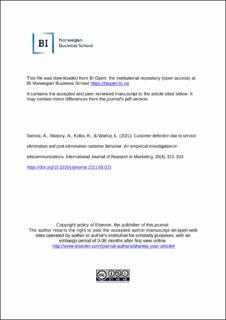Customer defection due to service elimination and post-elimination customer behavior: An empirical investigation in telecommunications
Journal article, Peer reviewed
Accepted version
Permanent lenke
https://hdl.handle.net/11250/3082344Utgivelsesdato
2021Metadata
Vis full innførselSamlinger
Originalversjon
10.1016/j.ijresmar.2021.03.003Sammendrag
Service industries require rapid innovations in their service portfolios to gain and maintain competitive advantages. Service elimination is a potential tool for portfolio renewal, though it might threaten increased defection rates. To contribute to both service elimination and customer defection literature, this paper proposes a model of customer responses to service elimination, with practical implications for decision-makers in rapidly innovating telecommunication markets. In particular, the main study, conducted in the context of Hungary’s telecommunications sector, reveals that customers’ tenure, usage intensity, and age reduce the negative effects of a price increase on their defection; the price increase, degree to which customers interact with service providers, customer defection, and competitive effects in turn increase post–service elimination usage intensity. These findings suggest implementation strategies that can reduce customer defection following price increase due to service elimination, by focusing on new customers, light users, and the quality of customer interactions.

